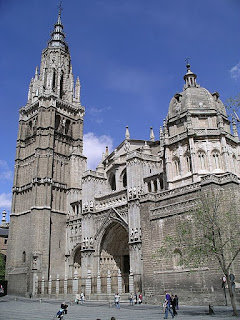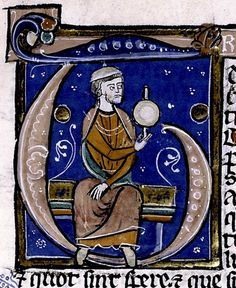His etymologies were worthy of the father in My Big Fat Greek Wedding who linked every concept to a Greek word. (The evidence suggests that Isidore was not well-versed in the Greek language.) Examples are that dominus (master) begins with "D" because so does domus (house), and a dominus is the master of a domus. Also, the Latin verb "to teach" is docere, which is related to docile (compliant) because compliant people can learn easily. He finds the origin of mendicus, the Latin word for beggar, in the Latin phrase manu dicere, "to speak with the hand," because (he says) there was an ancient custom for beggars to close their mouths and hold out their hand for food. Prostitutes (fornicatrix and fornicarius) are named from fornix, "arch," because they would hang about under an arch waiting for a client.
Among his other offerings:
—A table that explains family relationships ("Who is your second cousin twice removed?") and the terms for each family member.
—The classic "T" map of the world, the mappa mundi. (The illustration is from a 10th century copy, showing such a map.)
—How the four elements make up the body:
But flesh is composed of four elements: earth is in the fleshy parts, air in the breath, water in the blood, fire in the vital heat. The elements are mingled in us in their proper proportions, of which something is lacking when the conjunction is dissolved.
—Bodily functions:
The mouth is compared to the door of the belly which receives and passes on food to the intestines through the esophagus which is near the windpipe, and which is closed off by the epiglottis during deglutition.
The intestines are arranged in long circular entwinings so that food can be gradually digested. The abdominal viscera are separated from the heart and lungs by the diaphragm and covered by the omentum. Food, when first passed into the small intestine, is called jantaculum. The large intestine, the “blind gut,” is identified and it is pointed out that the gastrointestinal tract is open at each end. The rectum and anus are turned away from our faces to spare us the indelicacy of witnessing their evacuation.
—Medicine:
The poppy is the sleep-bearing herb, of which Vergil says [Georgics 1. 78]: Lethaeo perfusa papavera somno, ‘Heavy sleep, pressed out of the poppy,’ since it stupefies the sleeper. Some poppies are common; others are stronger, namely those from which flows the juice called opion.
...and many other topics, as mentioned above.
His Etymologiae was studied and copied and illustrated through the Middle Ages, and many versions of the manuscript exist in various museums.
One of the other notable things about Isidore is his family. His parents died early in the life of Isidore and his siblings, but all four children became saints; three became bishops. His older brother Leander has been mentioned, but not the rest. A brief look at his family next time.




















